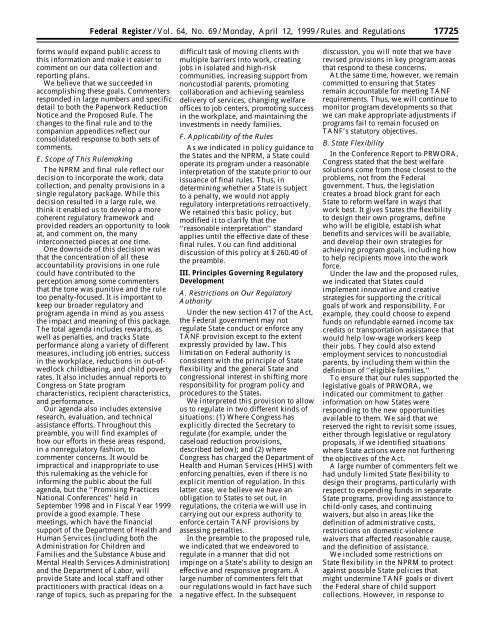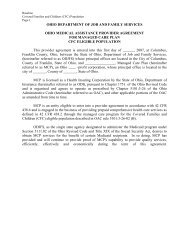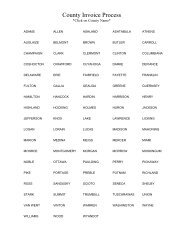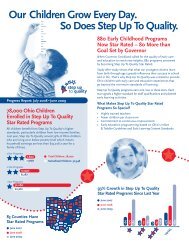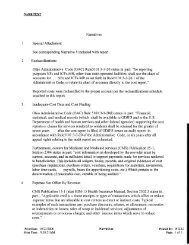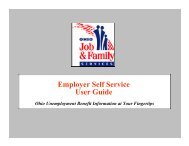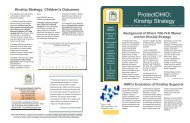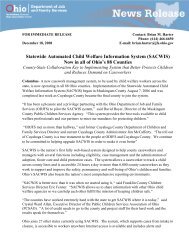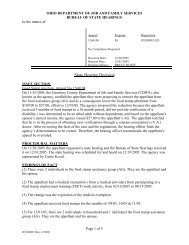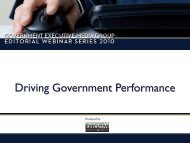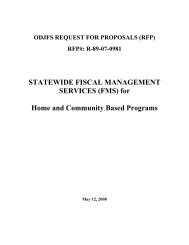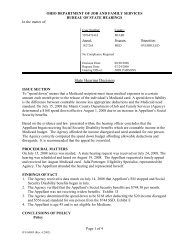Final TANF Rule as published in the Federal Register 4/12/1999
Final TANF Rule as published in the Federal Register 4/12/1999
Final TANF Rule as published in the Federal Register 4/12/1999
You also want an ePaper? Increase the reach of your titles
YUMPU automatically turns print PDFs into web optimized ePapers that Google loves.
<strong>Federal</strong> <strong>Register</strong> / Vol. 64, No. 69 / Monday, April <strong>12</strong>, <strong>1999</strong> / <strong>Rule</strong>s and Regulations<br />
forms would expand public access to<br />
this <strong>in</strong>formation and make it e<strong>as</strong>ier to<br />
comment on our data collection and<br />
report<strong>in</strong>g plans.<br />
We believe that we succeeded <strong>in</strong><br />
accomplish<strong>in</strong>g <strong>the</strong>se goals. Commenters<br />
responded <strong>in</strong> large numbers and specific<br />
detail to both <strong>the</strong> Paperwork Reduction<br />
Notice and <strong>the</strong> Proposed <strong>Rule</strong>. The<br />
changes to <strong>the</strong> f<strong>in</strong>al rule and to <strong>the</strong><br />
companion appendices reflect our<br />
consolidated response to both sets of<br />
comments.<br />
E. Scope of This <strong>Rule</strong>mak<strong>in</strong>g<br />
The NPRM and f<strong>in</strong>al rule reflect our<br />
decision to <strong>in</strong>corporate <strong>the</strong> work, data<br />
collection, and penalty provisions <strong>in</strong> a<br />
s<strong>in</strong>gle regulatory package. While this<br />
decision resulted <strong>in</strong> a large rule, we<br />
th<strong>in</strong>k it enabled us to develop a more<br />
coherent regulatory framework and<br />
provided readers an opportunity to look<br />
at, and comment on, <strong>the</strong> many<br />
<strong>in</strong>terconnected pieces at one time.<br />
One downside of this decision w<strong>as</strong><br />
that <strong>the</strong> concentration of all <strong>the</strong>se<br />
accountability provisions <strong>in</strong> one rule<br />
could have contributed to <strong>the</strong><br />
perception among some commenters<br />
that <strong>the</strong> tone w<strong>as</strong> punitive and <strong>the</strong> rule<br />
too penalty-focused. It is important to<br />
keep our broader regulatory and<br />
program agenda <strong>in</strong> m<strong>in</strong>d <strong>as</strong> you <strong>as</strong>sess<br />
<strong>the</strong> impact and mean<strong>in</strong>g of this package.<br />
The total agenda <strong>in</strong>cludes rewards, <strong>as</strong><br />
well <strong>as</strong> penalties, and tracks State<br />
performance along a variety of different<br />
me<strong>as</strong>ures, <strong>in</strong>clud<strong>in</strong>g job entries, success<br />
<strong>in</strong> <strong>the</strong> workplace, reductions <strong>in</strong> out-ofwedlock<br />
childbear<strong>in</strong>g, and child poverty<br />
rates. It also <strong>in</strong>cludes annual reports to<br />
Congress on State program<br />
characteristics, recipient characteristics,<br />
and performance.<br />
Our agenda also <strong>in</strong>cludes extensive<br />
research, evaluation, and technical<br />
<strong>as</strong>sistance efforts. Throughout this<br />
preamble, you will f<strong>in</strong>d examples of<br />
how our efforts <strong>in</strong> <strong>the</strong>se are<strong>as</strong> respond,<br />
<strong>in</strong> a nonregulatory f<strong>as</strong>hion, to<br />
commenter concerns. It would be<br />
impractical and <strong>in</strong>appropriate to use<br />
this rulemak<strong>in</strong>g <strong>as</strong> <strong>the</strong> vehicle for<br />
<strong>in</strong>form<strong>in</strong>g <strong>the</strong> public about <strong>the</strong> full<br />
agenda, but <strong>the</strong> ‘‘Promis<strong>in</strong>g Practices<br />
National Conferences’’ held <strong>in</strong><br />
September 1998 and <strong>in</strong> Fiscal Year <strong>1999</strong><br />
provide a good example. These<br />
meet<strong>in</strong>gs, which have <strong>the</strong> f<strong>in</strong>ancial<br />
support of <strong>the</strong> Department of Health and<br />
Human Services (<strong>in</strong>clud<strong>in</strong>g both <strong>the</strong><br />
Adm<strong>in</strong>istration for Children and<br />
Families and <strong>the</strong> Substance Abuse and<br />
Mental Health Services Adm<strong>in</strong>istration)<br />
and <strong>the</strong> Department of Labor, will<br />
provide State and local staff and o<strong>the</strong>r<br />
practitioners with practical ide<strong>as</strong> on a<br />
range of topics, such <strong>as</strong> prepar<strong>in</strong>g for <strong>the</strong><br />
difficult t<strong>as</strong>k of mov<strong>in</strong>g clients with<br />
multiple barriers <strong>in</strong>to work, creat<strong>in</strong>g<br />
jobs <strong>in</strong> isolated and high-risk<br />
communities, <strong>in</strong>cre<strong>as</strong><strong>in</strong>g support from<br />
noncustodial parents, promot<strong>in</strong>g<br />
collaboration and achiev<strong>in</strong>g seamless<br />
delivery of services, chang<strong>in</strong>g welfare<br />
offices to job centers, promot<strong>in</strong>g success<br />
<strong>in</strong> <strong>the</strong> workplace, and ma<strong>in</strong>ta<strong>in</strong><strong>in</strong>g <strong>the</strong><br />
<strong>in</strong>vestments <strong>in</strong> needy families.<br />
F. Applicability of <strong>the</strong> <strong>Rule</strong>s<br />
As we <strong>in</strong>dicated <strong>in</strong> policy guidance to<br />
<strong>the</strong> States and <strong>the</strong> NPRM, a State could<br />
operate its program under a re<strong>as</strong>onable<br />
<strong>in</strong>terpretation of <strong>the</strong> statute prior to our<br />
issuance of f<strong>in</strong>al rules. Thus, <strong>in</strong><br />
determ<strong>in</strong><strong>in</strong>g whe<strong>the</strong>r a State is subject<br />
to a penalty, we would not apply<br />
regulatory <strong>in</strong>terpretations retroactively.<br />
We reta<strong>in</strong>ed this b<strong>as</strong>ic policy, but<br />
modified it to clarify that <strong>the</strong><br />
‘‘re<strong>as</strong>onable <strong>in</strong>terpretation’’ standard<br />
applies until <strong>the</strong> effective date of <strong>the</strong>se<br />
f<strong>in</strong>al rules. You can f<strong>in</strong>d additional<br />
discussion of this policy at § 260.40 of<br />
<strong>the</strong> preamble.<br />
III. Pr<strong>in</strong>ciples Govern<strong>in</strong>g Regulatory<br />
Development<br />
A. Restrictions on Our Regulatory<br />
Authority<br />
Under <strong>the</strong> new section 417 of <strong>the</strong> Act,<br />
<strong>the</strong> <strong>Federal</strong> government may not<br />
regulate State conduct or enforce any<br />
<strong>TANF</strong> provision except to <strong>the</strong> extent<br />
expressly provided by law. This<br />
limitation on <strong>Federal</strong> authority is<br />
consistent with <strong>the</strong> pr<strong>in</strong>ciple of State<br />
flexibility and <strong>the</strong> general State and<br />
congressional <strong>in</strong>terest <strong>in</strong> shift<strong>in</strong>g more<br />
responsibility for program policy and<br />
procedures to <strong>the</strong> States.<br />
We <strong>in</strong>terpreted this provision to allow<br />
us to regulate <strong>in</strong> two different k<strong>in</strong>ds of<br />
situations: (1) Where Congress h<strong>as</strong><br />
explicitly directed <strong>the</strong> Secretary to<br />
regulate (for example, under <strong>the</strong><br />
c<strong>as</strong>eload reduction provisions,<br />
described below); and (2) where<br />
Congress h<strong>as</strong> charged <strong>the</strong> Department of<br />
Health and Human Services (HHS) with<br />
enforc<strong>in</strong>g penalties, even if <strong>the</strong>re is no<br />
explicit mention of regulation. In this<br />
latter c<strong>as</strong>e, we believe we have an<br />
obligation to States to set out, <strong>in</strong><br />
regulations, <strong>the</strong> criteria we will use <strong>in</strong><br />
carry<strong>in</strong>g out our express authority to<br />
enforce certa<strong>in</strong> <strong>TANF</strong> provisions by<br />
<strong>as</strong>sess<strong>in</strong>g penalties.<br />
In <strong>the</strong> preamble to <strong>the</strong> proposed rule,<br />
we <strong>in</strong>dicated that we endeavored to<br />
regulate <strong>in</strong> a manner that did not<br />
imp<strong>in</strong>ge on a State’s ability to design an<br />
effective and responsive program. A<br />
large number of commenters felt that<br />
our regulations would <strong>in</strong> fact have such<br />
a negative effect. In <strong>the</strong> subsequent<br />
17725<br />
discussion, you will note that we have<br />
revised provisions <strong>in</strong> key program are<strong>as</strong><br />
that respond to <strong>the</strong>se concerns.<br />
At <strong>the</strong> same time, however, we rema<strong>in</strong><br />
committed to ensur<strong>in</strong>g that States<br />
rema<strong>in</strong> accountable for meet<strong>in</strong>g <strong>TANF</strong><br />
requirements. Thus, we will cont<strong>in</strong>ue to<br />
monitor program developments so that<br />
we can make appropriate adjustments if<br />
programs fail to rema<strong>in</strong> focused on<br />
<strong>TANF</strong>’s statutory objectives.<br />
B. State Flexibility<br />
In <strong>the</strong> Conference Report to PRWORA,<br />
Congress stated that <strong>the</strong> best welfare<br />
solutions come from those closest to <strong>the</strong><br />
problems, not from <strong>the</strong> <strong>Federal</strong><br />
government. Thus, <strong>the</strong> legislation<br />
creates a broad block grant for each<br />
State to reform welfare <strong>in</strong> ways that<br />
work best. It gives States <strong>the</strong> flexibility<br />
to design <strong>the</strong>ir own programs, def<strong>in</strong>e<br />
who will be eligible, establish what<br />
benefits and services will be available,<br />
and develop <strong>the</strong>ir own strategies for<br />
achiev<strong>in</strong>g program goals, <strong>in</strong>clud<strong>in</strong>g how<br />
to help recipients move <strong>in</strong>to <strong>the</strong> work<br />
force.<br />
Under <strong>the</strong> law and <strong>the</strong> proposed rules,<br />
we <strong>in</strong>dicated that States could<br />
implement <strong>in</strong>novative and creative<br />
strategies for support<strong>in</strong>g <strong>the</strong> critical<br />
goals of work and responsibility. For<br />
example, <strong>the</strong>y could choose to expend<br />
funds on refundable earned <strong>in</strong>come tax<br />
credits or transportation <strong>as</strong>sistance that<br />
would help low-wage workers keep<br />
<strong>the</strong>ir jobs. They could also extend<br />
employment services to noncustodial<br />
parents, by <strong>in</strong>clud<strong>in</strong>g <strong>the</strong>m with<strong>in</strong> <strong>the</strong><br />
def<strong>in</strong>ition of ‘‘eligible families.’’<br />
To ensure that our rules supported <strong>the</strong><br />
legislative goals of PRWORA, we<br />
<strong>in</strong>dicated our commitment to ga<strong>the</strong>r<br />
<strong>in</strong>formation on how States were<br />
respond<strong>in</strong>g to <strong>the</strong> new opportunities<br />
available to <strong>the</strong>m. We said that we<br />
reserved <strong>the</strong> right to revisit some issues,<br />
ei<strong>the</strong>r through legislative or regulatory<br />
proposals, if we identified situations<br />
where State actions were not fur<strong>the</strong>r<strong>in</strong>g<br />
<strong>the</strong> objectives of <strong>the</strong> Act.<br />
A large number of commenters felt we<br />
had unduly limited State flexibility to<br />
design <strong>the</strong>ir programs, particularly with<br />
respect to expend<strong>in</strong>g funds <strong>in</strong> separate<br />
State programs, provid<strong>in</strong>g <strong>as</strong>sistance to<br />
child-only c<strong>as</strong>es, and cont<strong>in</strong>u<strong>in</strong>g<br />
waivers, but also <strong>in</strong> are<strong>as</strong> like <strong>the</strong><br />
def<strong>in</strong>ition of adm<strong>in</strong>istrative costs,<br />
restrictions on domestic violence<br />
waivers that affected re<strong>as</strong>onable cause,<br />
and <strong>the</strong> def<strong>in</strong>ition of <strong>as</strong>sistance.<br />
We <strong>in</strong>cluded some restrictions on<br />
State flexibility <strong>in</strong> <strong>the</strong> NPRM to protect<br />
aga<strong>in</strong>st possible State policies that<br />
might underm<strong>in</strong>e <strong>TANF</strong> goals or divert<br />
<strong>the</strong> <strong>Federal</strong> share of child support<br />
collections. However, <strong>in</strong> response to


